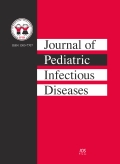Authors: Singhi, Sunit | Argent, Andrew C. | Baranwal, Arun K. | Santhanam, Indumathy
Article Type:
Research Article
Abstract:
Sepsis and septic shock are associated with significant mortality among children of developing economies. We review the current concepts in management of shock that are applicable to emergency room in resource poor setting. The emphasis is on simplified definition, early identification, and a time sensitive approach to reverse pathophysiological derangements using clinical endpoints.~Pathophysiology of septic shock includes hypoxemia, reduction in cardiac output and perfusion pressure, capillary shunting of blood past the tissue
…beds and increased oxygen consumption. Early recognition of sepsis/septic shock is aided by presence of fever, lethargy, altered mental states, tachypnea, tachycardia, central-to-peripheral temperature difference, mottled or cool extremities, abnormal capillary refill and reduced urine output. The management recommendations based on evidence include resuscitation of airway and breathing (first 5 min), administration of 40–60 mL/kg normal saline (5–40 min), early initiation of inotrope infusion (dopamine, 10 μg/kg/min; epinephrine, 0.1–0.3 μg/kg/min), ventilation (when indicated) and administration of the first dose of antimicrobials (20–60 min). Some children may require up to 90–110 mL/kg saline in the first hours. Colloids may be considered in patients with malnutrition and malaria. Hypoglycemia should be identified and corrected at the earliest. Little evidence supports correction of hypocalcemia and use of packed red cells (if hemoglobin is < 10 g/dL) in initial resuscitation. Initial therapeutic endpoints includes normalization of tachypnea, tachycardia, systolic blood pressure, peripheral perfusion pressure, normal capillary refill, urine output > 1 mL/kg/hr, level of consciousness, hepatomegaly and central venous pressure > 10 cmH_{2} O. Subsequent endpoints to be targeted include normalization of central venous oxygen saturation, and blood lactate. Vasopressor (norepinephrine) and inodilators (dobutamine and milrinone), and packed red cells may be used for optimizing these indices of global consumption/delivery deficit of oxygen. Ventilation, manual or mechanical if available, should be used.
Show more
Keywords: Children, emergency department, fluid resuscitation, septic shock, resource-limited setup
DOI: 10.3233/JPI-2009-0163
Citation: Journal of Pediatric Infectious Diseases,
vol. 4, no. 2, pp. 85-98, 2009
Price: EUR 27.50





